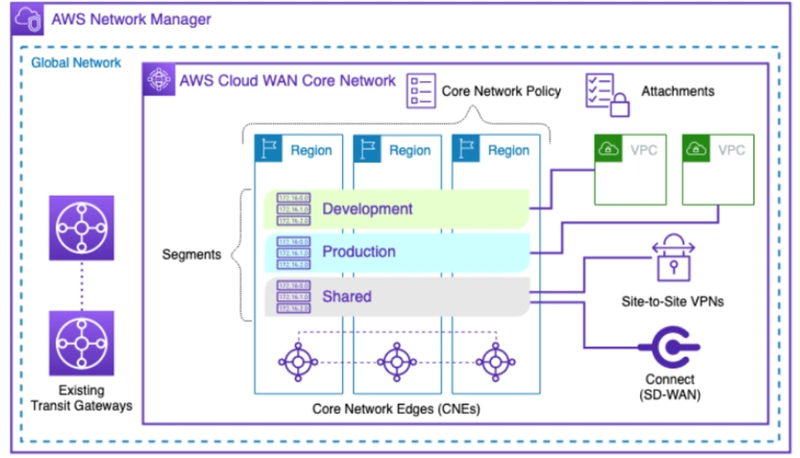As organizations grow and adopt cloud infrastructure at scale, the complexity of connecting multiple sites, AWS Regions, and cloud environments increases. AWS has offered Transit Gateway (TGW) to simplify networking, but in 2022, it introduced AWS Cloud WAN to address more complex global networking needs with even greater ease and control.
In this blog post, we'll explore:
🔹 What is AWS Cloud WAN?
🔹 Key components and architecture
🔹 Comparison with Transit Gateway
🔹 Pricing Comparison
🔹 Pros and Cons of Cloud WAN
🔹 What is AWS Cloud WAN?
AWS Cloud WAN is a managed wide-area networking service that allows you to build, manage, and monitor a global network connecting:
- AWS VPCs
- On-premises data centers
- Branch offices
- Remote users
—all using a central policy-driven approach.
It provides a unified global network with integrated monitoring, automation, and security policies.
Think of it as your cloud-native SD-WAN solution for global connectivity across regions and hybrid environments.
🧱 Key Components of AWS Cloud WAN
Global Network
Core Network & Core Network Edges (CNEs)
Segments* (like VRFs for network isolation)
Attachments: VPCs, TGWs, VPNs, SD-WAN
Policy Documents: JSON-based control over routing and connectivity
🔄 Cloud WAN vs Transit Gateway: A Side-by-Side Comparison
| Feature | AWS Transit Gateway (TGW) | AWS Cloud WAN |
|---|---|---|
| Scope | Regional | Global, Multi-Region |
| Routing | Route Tables per TGW | Segments + Policy-based Routing |
| Management | Manual (Console/API) | Centralized, Policy-Driven |
| Monitoring | CW Metrics, Flow Logs | Cloud WAN Dashboard & Metrics |
| Third-party Integration | Limited | Native SD-WAN, VPN Support |
| Multi-Region Networking | Inter-region peering needed | Built-in, seamless |
| Granular Routing Control | Moderate | High (Segments + Policy) |
| Automation & Scaling | Manual configuration | High automation |
💰 Pricing Comparison: TGW vs Cloud WAN
📌 AWS Transit Gateway (TGW)
-
Data Transfer:
-
$0.02/GBfor VPC attachments -
$0.05/GBfor inter-region peering
-
-
Attachment Hourly Charge:
-
~$0.05/hourper VPC attachment
-
-
Inter-Region Peering:
- Incur charges at both ends
- Can be costly at scale
📌 AWS Cloud WAN
-
Core Network Edge:
-
~$0.05/hourper Region
-
-
VPC Attachments:
-
~$0.015/hourper attachment
-
-
Data Transfer:
-
$0.02/GB(same Region or inter-Region)
-
-
TGW Attachments (optional):
-
~$0.075/hourper TGW attachment
-
💡 Cost Perspective
| Use Case | TGW | Cloud WAN |
|---|---|---|
| Small-scale (1–2 Regions) | ✅ Cheaper | ❌ Overhead |
| Medium to Large Multi-Region | ❌ Complex | ✅ Efficient |
| SD-WAN or VPN Integration | ❌ Manual | ✅ Built-in |
| Centralized Policy Management | ❌ Limited | ✅ Included |
Advantages of AWS Cloud WAN
- Global Network Management
- Centralized Policy-Based Routing
- Integrated Monitoring and Dashboards
- Segment-Based Network Isolation
- Native SD-WAN / VPN Support
- Less Manual Overhead
Disadvantages of AWS Cloud WAN
- Higher Complexity for Small Deployments
- JSON Policy Learning Curve (simpler policy can be created from console)
- Potentially More Expensive in Small Setups
🧠 When to Use What?
| Use Case | Best Fit |
|---|---|
| Single-Region, simple VPC-to-VPC connectivity | Transit Gateway/VPC Peering |
| Multi-Region, global architecture | Cloud WAN |
| Hybrid networks with SD-WAN integration | Cloud WAN |
| Environments needing strong traffic isolation | Cloud WAN |
| Existing TGW setup in one Region | Transit Gateway |
| Centralized routing policies | Cloud WAN |
✅ Final Thoughts
AWS Cloud WAN is designed for the future of cloud networking—offering centralized control, global reach, and integrated security and segmentation.
While Transit Gateway remains a solid choice for simpler environments, Cloud WAN delivers serious value when operating across multiple regions, integrating hybrid workloads, or needing SD-WAN support.
💬 Got thoughts or questions on AWS networking? Drop them below, or share your real-world architectures!






Top comments (0)